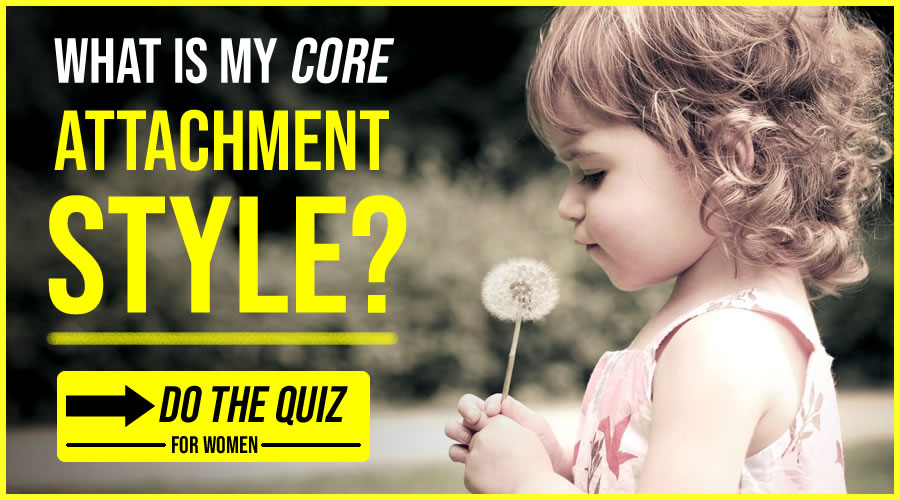Wondering how to communicate to an avoidant partner? You’re not the only one.
Through experience, I know that being in a relationship with someone who is emotionally disconnected is incredibly tough – you feel like you can’t open up to them.
On top of that, when you do try to share your perspective, feelings or story, they often run away or just make you feel guilty for burdening them with your emotions.
We all have baggage but when that leads to conflict in adult relationships, you really need two emotionally resilient partners to weather the storm.
Being With An Avoidant Can Feel Lonely
Being in a relationship with an avoidant partner can make you feel like you are alone in facing conflicts with courage, and in making the relationship healthy.
Every avoidant person does not act in the same way though, obviously.
That said, there are some common traits that can help us understand whether our partner has this kind of attachment style or whether they are closed up for some other reason.
To identify if your partner has an avoidant attachment style, look for the following cues:
1. They will avoid talking about their emotions, period.
Whether you want to know their life story or what their work day was like, they will give the juicy details but will never share how they felt during it all. Being vulnerable is the last thing they want to do (or can) do.
2. They will seem uninterested in your emotions too.
You might want to vent about a fight with your best friend, but what you’ll receive from them will often resemble apathy or indifference.
This doesn’t mean that an avoidant will never show empathy or interest, but just that most of the time they’ll treat emotions with indifference and try to gloss over them or run away from them.
This can hit hard when you need them to be emotionally available for you during the bad times.
They might not even be doing it to be cold, but rather it’s just a habit they have to intellectualise and focus on logic rather than experiencing emotions, even if the emotions aren’t their own.
Recommended: 8 Signs An Avoidant Loves You + How To Inspire More Of It.
3. They may feel distant physically and mentally.
This is because people with an avoidant attachment style are emotionally unavailable and have an innate tendency to protect themselves from harm.
The downside of that is that they end up losing out on meaningful connections too.
MORE: 13 Warning Signs Of An Emotionally Unavailable Man.
4. They don’t like to ask for help either.
This is an extension of the last point and reinforces how they need to be self-reliant rather than indulge in the healthy mutual dependency that is required for relationships to prosper.
Asking for help makes an avoidant feel vulnerable, and they don’t like to need anyone for fear that the other person will see them vulnerable, think less of them, or worse – that the other person may need them too.
You Have A Choice To Make Now…
Once you have figured out whether you are in a relationship with someone who fits the signs of being an avoidant, you can then make a choice.
Either leave (knowing that dealing with any avoidant is seriously hard work), or stick around and try to make things work.
Recommended: Walking Away When He Won’t Commit: 6 Guilt-Free Reasons To Say Goodbye.
In most cases, I recommend the second option – sticking around and trying to make things work. That way you won’t have to regret not putting in an effort.
If you do decide to stay, we have listed some helpful tips on how to communicate with an avoidant partner.
These will not only help you get through the wall they’ve created around them but also make them realise that you understand what they need, potentially encouraging them to give you what you need too!
(Why is this important? It is because your core attachment style largely dictates and influences what happens in your relationship. Thus it’s imperative you understand your core attachment style!)
10 Little Known Ways To Communicate To An Avoidant Partner
#1: Give Them Space And Privacy
This one is no secret. Avoidants cherish their privacy and end up feeling suffocated if you get in their face.
So:
By understanding that their privacy is vital to them, you can show your acceptance of them.
When you give someone the freedom to be comfortable, they’ll automatically feel a sense of gratitude towards you.
You might think that your avoidant partner doesn’t notice or that they take it for granted. But for them, knowing that they are with someone they can trust (and is willing to give them what they need) will improve your relationship greatly.
Bottom line:
When thinking about how to communicate with an avoidant partner, sometimes you will have to think about not saying anything at all.
Just simply being there physically might be enough.
This doesn’t mean that pushing for more intimacy (trying to break through their walls) is always off the cards when trying to communicate with an avoidant partner.
There definitely will be times when enough is enough – and you need to respectfully and lovingly break open their walls.
But a lot of the time, when dealing with an avoidant you need to let them try to regulate their emotions first (by seeking the safety of privacy and space).
#2: Don’t Chase
This step is very important, not just for your avoidant partner but for you as well.
Avoidants usually cannot handle confrontation and nor can they handle an emotional person chasing them or trying to force them to feel emotions they don’t want to feel.
They are also not very good at being forced to face conflicts or being pushed to face their wrongdoings.
(Instead, you can bring up their wrongdoings or your own grievances in a more gentle manner when they are relaxed and in a moment of trust with you).
I also understand that you may not trust your avoidant partner very much, so will be compelled to keep tabs on their whereabouts.
But if you are constantly checking in with them and holding on tighter when they want to be left alone, then you will likely make your avoidant partner feel very frustrated.
Secondly, constantly asking someone where they’re going, why they’re going and what they’re up to can be taxing on you too.
So, why not take a break from it?
You don’t need to carry the burden of staying connected with your partner when it’s clearly not what they want.
So what can you do instead of chasing?
Instead you can find gentle ways to show you care and make them feel safe.
Some things you can say to show you care (and aren’t trying to control them) are:
- I’m here for you when and if you’re ready to talk
- I’d love to hear about your day, did anything fun happen?
- I missed you today, did you enjoy your day?

#3: Be Their Rock
Answering the question of how to communicate with an avoidant partner will be easier when you come from a place of understanding them.
So let’s briefly build on this understanding now.
Research has shown time and again that the reason why an avoidant attachment style develops is because as a child, these unlucky souls did not have their emotional needs met.
For example, when your partner was under stress and reached out to his or her caregivers, their caregivers would be either unavailable or cold.
That’s why your partner now doesn’t want to open up. These walls they have built around themselves serve as a defence against further disappointments.
So:
What you can do to be your partner’s rock and make them realise that you want to be there for them is to give him or her the certainty that you won’t run away or turn cold.
Your task is to give them the assurity that you genuinely care and that you can be there for them, so that they begin to relax and trust you more. In turn, you’ll find that the quality of your relationship and your connection will improve.
Your job as a caring and emotionally available partner is to reassure your lover that no matter what emotions they have, you still love them and that you’re there for them.
Reassuring them of your love and physical presence can help them feel safe and maybe with time, they’ll trust the attachment process for the first time.
And when they begin to trust the attachment process, you’ll find that your partner will open up sooner than you think.
Does this sound like a lot of work? It definitely is if you also have insecure attachment patterns yourself.
But for someone who is securely attached, this process will be a lot less stressful for them and will feel a lot more like a challenge.

#4: Patience
Avoidant partners require some time to overcome their fear of intimacy and to emotionally connect.
If you have anger issues or struggle with regulating your own emotions, you may not be the person to offer your partner the patience needed to see them open up.
But patience is essential. By standing by your partner and allowing them to open up as much as they want, in the way they want, you can build trust with them.
Some things you can say to show that you are patiently waiting for them are:
“You seem upset, do you want to talk or do you need some space to unwind?”
“I’m here when you’re ready to talk about what’s bothering you.”
“If you don’t want to talk about it, we can do something else.”
#5: Communicate Your Needs Clearly And Lovingly (Without Blame)
Avoidants usually don’t perceive and understand their own emotions, let alone yours. As such, they don’t know how to be there for others.
You’ll find that your partner is emotionally unavailable because they don’t know how to be there for you, and they don’t know what to say.
This does not mean that your partner doesn’t ever want to be there for you – they very well might want to!
It just means that you’ll have to calmly state your feelings and needs in a non-blaming way.
By making it clear for your partner, you’ll remove the burden of doing guess work off them.
Once your partner hears what you need, they will also be able to let you know what they can or cannot do, potentially also addressing any unrealistic expectations you might have.
#6: Let Them Know The Value Of Emotions
As we’ve established, avoidants don’t really understand the importance of emotions in relationships and life, because they have an aversion to being vulnerable (and emotions equal vulnerability).
So your job is to gently suggest to your partner that without emotions, relationships would lack richness, depth and trust.
Let your partner know that you understand the importance of logic and objective thoughts, but even babies use emotions to communicate – and without emotions (and without their mother’s ability to perceive and empathise with these emotions, babies wouldn’t survive let alone thrive).
You don’t have to suggest that logic is inferior to emotion, but rather, that emotions are just as important.
Also let them know that you would never see them (or yourself) as less due to feeling intense emotions like shame, hurt, anger or disappointment.
Rather, emotions are a chance for both of you to understand each other better, calibrate better to each other’s needs and to give each other what you need.
#7: Don’t Let Your Insecurities Be Your Guide
When your avoidant partner pulls away, it’s easy to fear that you have done something wrong.
You might think that they are pulling away because they don’t want to be there for you or that they don’t love you anymore.
At that point, check in with yourself:
Is your partner emotionally unavailable because of their own patterns or because of something you have done?
Related: 10 Reasons Why Men Pull Away & What To Do About It? [The ultimate Guide].
Perhaps you have a fear that it’s your fault based on your own past experiences?
If it really is something that you’ve done to cause your partner to pull away, then you can possibly rectify that by apologising and meeting your partner where they are at.
But don’t automatically get scared and think it’s all your fault, that your partner hates you, or that you’re not enough.
Remember:
Avoidants have a pattern of pulling away and shutting down, whether you’re in the picture or not!
So:
Checking in with yourself and identifying what insecurities you might be projecting on to this relationship is crucial.
It’ll help you communicate your needs better and encourage you to communicate these issues properly to your partner.
Your relationship won’t be clouded by past experiences and you can build a healthy relationship based on the present.
#8: Actively Set Boundaries That Serve You And Them.
We’ve all heard of the concept of boundaries in relationships. Well, boundaries are especially important when you’re in a relationship with an avoidant.
Why?
Because an avoidant has poor boundaries, which can be toxic to both themselves and to you.
Related: Fearful Avoidant Vs Dismissive Avoidant: Differences & FAQ.
So, how can you communicate to an avoidant partner that there are certain boundaries you would like to set?
Here are some things you can say that might help you set clear boundaries – and to understand your partner’s needs more:
“I would like to know how you need me to respond when you are angry or upset.”
“How can I help you feel better when you are down?”
“What can I do to make you comfortable enough to open up to me emotionally?”
Some ways you can communicate what your needs are:
“I prefer talking through my emotions. Is that something you’re comfortable with?”
“Things that you can do when I’m upset are…”
“When I get upset or angry I react by….”

#9: Respect Your Differences.
Why respect your differences? How would that help you figure out how to communicate to an avoidant partner?
It helps because it aids you in keeping an open mind.
Not only that, but by always assuming that your partner will see things differently to you and fear different things to you, you can be receptive to them.
By being receptive to your partner, you can meet your partner where he or she is at and give them a chance to feel connected to you.
Once your avoidant partner feels connected to you, then you have all the power in the relationship – because you can get them to open up and form an inseparable bond with you.
So remember:
We are all unique. We experience things differently and have different perceptions and beliefs because we were all raised differently.
Even within the same family, each child ends up developing completely different personalities because of a mixture of all the things we experience.
While it’s important to stay true to yourself, it’s also important to respect the other person for being who they are.
We sometimes forget that our lover is a whole other person who has had different influences to us and has been through very different experiences to get to where they are today.
So:
Your rules for relationships may not be your partner’s rules.
In fact, if you’re securely attached and dating an avoidant partner, you can guarantee that they have different rules for relationships than you do.
Let’s respect that and try to appreciate our differences, simply so that you can inspire calmness and trust in your avoidant partner.
Communicating that you respect that they’re different to you is very important. It shows you empathise with them and are willing to understand them.
#10: Don’t Let The “Avoidant” Label Hold Your Partner Back
One of the most important things to convey to your partner is that you know they have the potential to be anything they aspire to be.
When we get stuck in the attachment style labels and continually call our lover an avoidant, they will come to believe that they are only that – and nothing more.
This is bad for ourselves or for our partner, as we don’t leave any space for change, and more importantly for growth.
It is important to know how to communicate to an avoidant partner, but it is very important to also remember that they might not always be an avoidant.
They have the capacity and the potential to be secure in relationships too.
Plenty of people are learning to become securely attached every day. It is called “earned secure”.
So if your partner always seems invulnerable, I know it may be frustrating, but ask yourself: have you EVER seen evidence of them being vulnerable?
If your partner isn’t very empathetic, ask yourself if you have EVER seen them have empathy for another person?
If you have, encourage them and let them know that they are also a deeply feeling, beautifully vulnerable human whom you respect enormously.
See:
Communicating that you see other sides of your partner might help them grow out of their insecure behaviours.
This doesn’t mean that you have to ignore bad treatment from your partner (because avoidants can be very toxic at times), it just means that people often act according to what others expect from them.
If everyone expects you to be an asshole, then you might just always be an asshole.
But if the person closest to you sees the vulnerability in you and encourages that, then maybe you can relax out of the asshole behavior and become more attached – and therefore more empathetic.
Take Care Of Yourself First
While it is important to hold space for your partner and communicate with them openly, you also need to ensure that it doesn’t take a toll on you.
If a relationship constantly requires you to give more than you receive, then maybe that relationship is not for you.
Answering the conundrum of how to communicate with an avoidant partner is definitely tough – but it’s not impossible.
If you’re sure that they are the one, then go full throttle and be the person they can start their journey of becoming secure with.
Remember Marlin, Nemo’s dad? He would’ve continued being closed up and emotionally unavailable had he not been given the acceptance and love that Dory showed towards him.
She helped set an example for him many times (getting them eaten by sharks is obviously not the best one!) and through that he learned to be open himself as well.
By leading with your own vulnerability and acceptance, you can definitely inspire more of that in your partner.
I truly believe that somewhere deep down, most of us do know what is right and what is best for us. We just don’t know the right behavior and no one has inspired us to act differently.
When your avoidant partner has a good role model in you to ‘go first’, they’ll come to understand that despite their shortcomings, over time they too can become more connected to you – and to all of life.
It just takes time and patience.
So remember: even in our relationships, all we need to do is just keep swimming!
Now over to you. What’s your experience trying to communicate with an avoidant partner? Do you have any questions that need answering? Just leave them below!

Stef Z is an Ecuador based writer dedicated to community work, writing, and theater. She’s dedicating most of her time helping women go through difficult breakups, domestic violence, as well learn the secret language of men.
